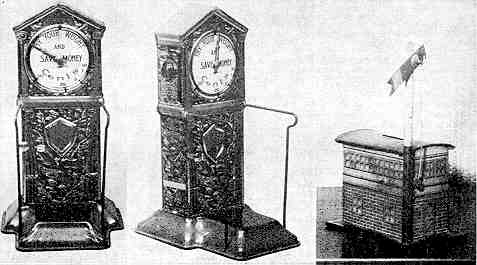Some Recent "Finds"
by F.H. Griffith - HOBBIES Magazine - October, 1968

There has been considerable activity in the field of collecting mechanical banks in recent months and certain of this activity has unearthed some quite rare banks. To bring our readers up to date on some of this action — for example, Edwin H. Mosler, Jr. has acquired among other banks the Robot, Woodpecker, and a Signal Cabin. Mr. Mosler, recently in Europe, had the good fortune to run across The Robot when in England. This is certainly a rare find and the second example known to exist. Please refer to Hobbies, May, 1968, for information on the first known example of this bank. Speaking of The Robot, the only additional information we have been able to ascertain as of this writing is that the word "Robot" was first used in a play, Copek’s R.U.R., in 1920 with reference to a substitute for a human workman, or a mechanical man. It may well be that Starkie called the bank The Robot with complete reference to the figure of the postman as representing a mechanical man.
The Woodpecker acquired by Mr. Mosler is a fine complete original specimen and the small elusive tin Signal Cabin is also in nice condition. The Signal Cabin, like numbers of the tin banks, is a tough item to add to a collection. Frankly it doesn’t have the attractiveness of some of the other tin mechanicals, but this is somewhat beside the point as it is a challenge to acquire one of these banks — they just don’t seem to turn up very often. Frankly the writer feels it is most likely there are individuals possessing the Signal Cabin that don’t necessarily realize it is a bank. After all, the small brick-like building with the semaphore that moves up and down does in fact look like a train set accessory, something to go with an electric or wind-up toy train. See photo "Signal Cabin."
Further news concerns Aaron Schroeder who recently added a very nice example of the Darky Bust (HOBBIES, June, 1968) to his collection. While identical in color to the other then known examples, his, unlike the one pictured in the June article, does not have a locking coin trap.
And yet another Darky Bust has turned up! This one in mint condition, no coin trap, but different coloring. The colors are as follows: Turban is red with black tassel down the back, the jacket is a loud checkered red and black with gold buttons. A gold shirt, red string tie, and gold vest striped in red are the differences in coloring as compared to the other known examples. It’s amazing when we consider that the bank was definitely sold in 1907 by Butler Brothers and it was only in recent years that the first example was found. Then in a comparatively short period of time three examples turn up more or less in succession. Sure makes the hobby interesting!
Following through with Mechanical Bank Ramblings for March, 1968, we are now able to go into detail on the recent discovery by Mr. Schroeder of the Try Your Weight Bank. This bank is shown in Figures 1 and 2. It, like the Darky Bust, was pictured for sale in the 1907 Butler Brothers Catalog. We quote from this catalog:
"Automatic registering bank, litho in colors, gilt stripes, upright cabinet on raised platform, numbered dial with moving hand, will register 1, 5, 10, 25, and 50 cents when inserted in slot after lever is pressed, brass lock and key at base. ht. 6-3/8 in., ½ doz. in box. Doz $1.95."
This bank, while referred to as a registering bank as per above, is in the writer’s opinion a mechanical bank and not just a registering bank. It in fact registers nothing. The hand on the dial points to the amount of the coin deposited. This action is caused by the weight of the coin. Then when the lever is pressed the coin is released from the inside mechanism and the pointer hand returns to its normal position. Nothing is registered, only the type coin is designated, that is, if a penny, nickel, dime, and so on.
The Try Your Weight Bank is a very attractive item in the following colors: The base of the scale, top, and entire back is red, as is the medallion centered under the face of the scale. The drape effect on each side of the front is also red. There is various gold outlining and decoration of the peak, sides, medallion and scale face. Each side and front has interesting decorative effect in blue, green, brown and red. A small rural scene in circular form appears on each side. The lettering "Try Your Weight and Save Money" and "Cents" is black and the numerals are red. The face of the scale is white and a small white section with "Press Here" written thereon is by the coin release and resetting lever. The scale platform section of the base is a mottled blue, red and black. The picture in each circle on either side, by the way, consists of a German type thatched cottage with tall trees and sunset.
Figure 1 shows the bank front view. In Figure 2 the coin slot and lever are well defined as is the small circular picture referred to in the description of the coloring. Other than "Made in Germany" on the bottom left side, no other markings appear on the bank.
